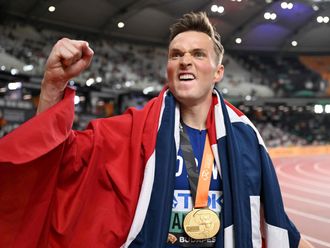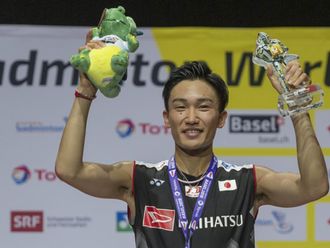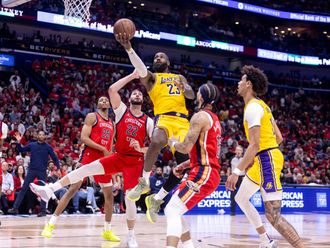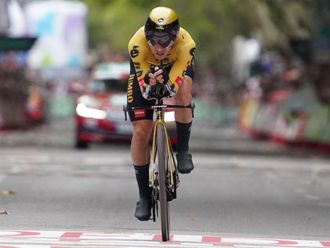Dubai: Tradition states that the America’s Cup winners get to pick the design of the yacht for the next edition of the race, and 2017 champions Emirates Team New Zealand (ETNZ) will listen carefully to what the international sailing community wants before deciding, according to ETNZ chief executive Grant Dalton.
As winners of the past three editions of the two-yacht race, which has run every three or four years since 1851, Oracle Team USA, backed by billionaire Larry Ellison, have opted for foiling catamarans, which lift up off the water and ride on their hydro-foils at speeds of up to 50 knots (93km/h), or four times faster than the wind.
These creations — used in 2013 and 2017 editions of the race — are more expensive at £10 million (Dh47 million) a pop, and more dangerous, having claimed the life of Artemis’ Andrew Simpson in 2013. However, they push the limits of design and technology, and entice more viewers to watch the sport due to their speed and excitement, and their ability to sail closer to the shore.
Purists, however, argue that it distracts from the spirit of the race, with the Auld Mug – the oldest trophy in sport - having built its legend around slower and cheaper mono-hulls, which are not only more accessible and less elitist to inspire the average weekend sailor, but they also embroil all six crew in the battle.
In its current state, only two crew are actually sailing while the other four are creating power to winch the sails and adjust the foils.
And whereas before a designer would craft a hull to glide through water with least resistance, now the bottom of the boat doesn’t even touch the water.
Like a rich, boring, and dominant Formula One team that wins every race, Oracle picked this design in the hope of stretching ETNZ’s ability to keep up financially. It costs around $100 million (Dh367 million) to compete, but Ellison has been splashing $250 million to $300 million on title defences.
However, this time around ETNZ outwitted their opponent with an innovative cycling mechanism to adjust the foils and winch the sails through leg power, while Oracle used arm power. Leg power is, of course, stronger than arm power and Oracle subsequently went on to lose 7-1 to ETNZ in Bermuda last week.
ETNZ now gets to decide on the design of the boat for the next edition of the race to be held in Auckland in 2021. And with Italy’s Luna Rosa, their opponents for that race, said to favour a return to mono-hulls, the sport is faced with a curious dilemma; push the limits further or revert to more affordable and inclusive tradition, because after all, this is about sailing not cycling, right?
“I think there are pros and cons to both and only degrees in the right decision,” Dalton told Gulf News in Dubai on his way back to Auckland via the UAE from Bermuda this week.
“Certainly in Bermuda the boats were pretty amazing but they suffer from not having real involvement of many yachtsman, it’s basically four guys pumping oil and two guys sailing, and they are only really able to sail in flat water otherwise they tip off their foils, so we’ll have to sit down and think it through.
“It’s still sailing, it’s just different,” he said of foil catamarans. “We’ll start with a blank canvas, see what the community wants and then try to make the right decision.
“Everyone is going to have an opinion and we cannot please everyone but at best we’ll split opinion 50-50. We want to make the right decision and investigate both options properly.
“We are in a generation of speed and foiling, so whatever happens has to be quick, fast and exciting. They have to be technically difficult and innovative but that can apply to both formulas - mono or multi-hull. We want to see what the world wants and then we will make a decision.”
In an apparent dig at Oracle, Dalton ensured that whatever happened, sailing would be back on a level playing field in Auckland, with budget caps and nationality rules speculated. At present seven of the 10 Oracle Team USA crew hold Australian passports, a factor that rightly riles Team New Zealand, who are ironically themselves skippered by an Australian in Glenn Ashby.
“The unique thing about the cup – and it’s a positive and a negative – is that the defender controls the rules,” said Dalton.
“These have been the rules imposed on us, we don’t dislike them but we also didn’t have a choice, we had to play by their rules and going forward they’ll play by ours, however we’ll be very deliberate in making those rules fair.
“We are completely committed to that because that’s how it should be. We believe it’s a privilege to hold the America’s Cup not a right.
“If we do go on to dominate it will be simply because we are better not because we jemmy the rules to make it easier.”
Asked if ETNZ would have won more than just three America’s Cup titles (1995, 2000 and 2017) if things were fairer, Dalton clammed up. “I don’t know”, he said with a wry smile.
Interestingly, ETNZ skipper Glenn Ashby and helmsman Peter Burling both agreed that sailing shouldn’t lose the excitement it has gained through foil racing.
“For me, the America’s Cup is a lot about technology, what you can build and how hard you can push structure,” said Burling. “That’s something I’m really passionate about and these boats really do push that so much.”
From 1851 to 2007, the speed of boats only increased from 12-18 knots (22-33 kph), but since then with foil catamarans, the speed has risen from 18 to just below 50 knots (93 kph).
“It is not just breakthroughs of 0.1 of a knot, its knots at boat speed. And compared to the amount spent in the past on more traditional boats to get such minimal speedage, the technology and rate of progression at the moment is something that’s really important for the America’s Cup to be right at the forefront of technology,” added Burling.
“These really high performance multi-hulls have shown how they can be sailed at a really high level and it would be a shame to step back from that.”
Ashby agreed: “Foiling technology will be around forever, we’ve pioneered it and I believe that whatever happens foil-borne craft will be very much on the agenda.
“Everything is about balance, we’ve seen some fantastic racing recently and personally as a yachtsman, whatever happens, I’m just pleased to be involved in the latest design technologies and I’m sure that whatever boat we end up with, it will be awesome to sail and will showcase our sport extremely well.”












